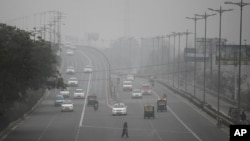The New Delhi government will restrict cars on the streets for another two weeks to fight the extreme air pollution that has made the Indian capital the world's most polluted city.
Private cars will be allowed on the streets on alternate days from April 15-30 based on even or odd license plate numbers, Arvind Kejriwal, the city's top elected official, said Thursday.
The first phase in January was welcomed by people but couldn't be done permanently because the city's public bus system was inadequate, Kejriwal told reporters.
The advocacy and research group Center for Science and Environment lauded the formula and said air pollution after the first trial returned “with a vengeance.” It saw a more than 50 percent jump in pollution levels on the first working day since the Jan. 1-15 trial.
The group said PM2.5 levels averaged 277 micrograms per cubic meter citywide, in the `severe' category. The measurement of particulate matter 2.5 micrometers in size was 281 microgram per cubic meter in the last week of January.“
The odd-and-even scheme has proved that the city needs curbs on high traffic volume to pull down peaking of pollution, reduce congestion that further increase emissions, and cut direct exposure to toxic vehicular fumes,” it said.
India's top court also this month set the terms for pollution control in and around New Delhi - advancement of Euro VI emissions standards, augmentation of public transport, closure of a coal-based power plant and stronger action on waste burning, construction dust and road dust.
The World Health Organization said last year that the Indian capital had the worst air quality in the world in 2014, surpassing Beijing.
Air monitoring sensors around the landlocked Indian capital routinely register hazardous levels of pollution, especially in winter.






